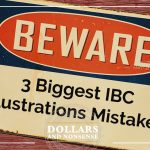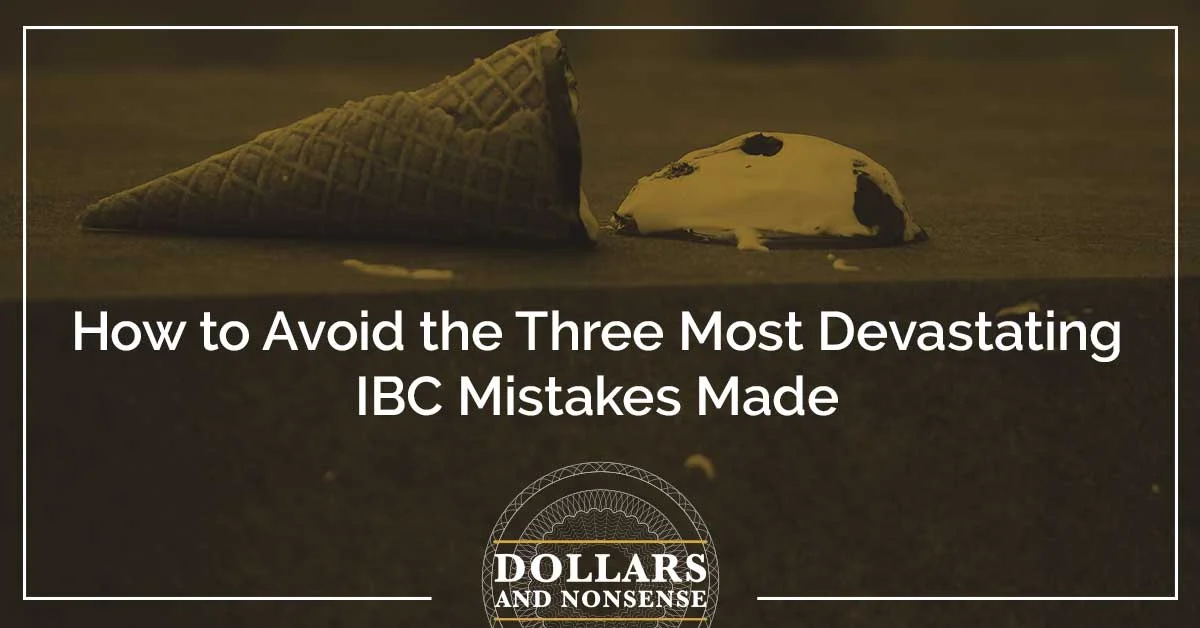In this episode, Nate and Holly discuss the biggest misconceptions about policy loans and how to avoid them in this episode. Unfortunately, these are the misconceptions many people believe when they get started with the Infinite Banking Concept that can lower their wealth-building trajectory.
Topics discussed in this episode:
- Understanding the process of why and when you take policy loans
- What actually takes place with policy loans and How to Utilize those with your policy
- What’s the point of ever borrowing from Policy Loans?
- The Three ways for a Policy to grow
- Why the real power in IBC is the capitalization of the policies
Episode Resources:
-
- Gain access to our Beginner’s Course now FREE to listeners of the podcast here now
- What is Infinite Banking
- Who was Nelson Nash?
- CREDIT: Episode art background photo by LinkedIn Sales Solutions
Podcast transcript for episode 164: Huge Policy Loan Mistakes People Make – A Guide to Infinite Banking Success
Nate: In this episode, we discuss the biggest misconceptions about policy loans that many people believe when they get started with the Infinite Banking Concept. She’s Holly, and she helps people find financial freedom.
Holly: He’s Nate. He makes sense out of money. This is Dollars and Nonsense. If you follow the herd, you will be slaughtered.
Nate: All right, everyone. Welcome back to the show. It’s so fun to do this, so fun to have you guys. Today, Holly, we’re talking about something we’ve talked about before, so this is not exactly brand-new information, but we have what, 160 some episodes now out?
Holly: Yes.
Nate: It’s been a little while since we’ve brought this up, so we wanted to tackle some of the biggest misconceptions people have specifically about policy loans, and there’s a lot of them. So, I guess we could dive into that, Holly, of misconceptions. Anything before we dive in that you wanted to share about this?
Holly: I would say that we get this question a lot, Nate, and that’s one of the reasons why we’re addressing it. I mean, I can tell you even yesterday, I had a client ask me about their policy loan and “Oh, can I just borrow it back out and pay it back, the snowball effect? It’s going to make my policy grow exponentially.” So, this is an individual, individuals, they even have policies, but they don’t truly understand the process of why you take policy loans or when you can, and the misconceptions, because everybody has a different viewpoint or opinion on it. I think that’s the importance of addressing it, is understanding what actually takes place with policy loans and how to actually utilize those with your policy.
Nate: So, as you brought up, Holly, maybe the first one that we could talk about would be the idea that becomes very prevalent, that the more money I borrow, the better my policy is going to grow. I think us as IBC practitioner teachers, it’s our group that’s to blame for some of this, I really do think. I think even the roots go all the way back to Nelson Nash too because in his book, in the equipment financing section of Nelson Nash’s book, Becoming Your Own Banker, the book that coined the term infinite banking and really started this whole thing, in that example, he went through scenarios where the more they used the policies, the better the policies became. We want to nip that at the bud and say that Nelson Nash can be right, and you can be wrong at the same time because there was some complexity happening under there.
So, in the examples that he was doing, he was showing how a real life scenario of an individual in the logging business who was financing trucks for the business could take over the financing of those trucks using policy loans and then pay back the policy loans, exactly what he was paying the truck folks, the truck financing folks, and end up keeping all the money that the financing company was making off him. So, the numbers look awesome, and it goes really well. This was, by the way, back in the ’90, so the interest rates here are not really that relatable, but back in the ’90s, it was a leasing agreement, and the real interest rate was close to 15% that that truck owner was using to lease the trucks, really. The policy loan rate that he was borrowing from the insurance company was only 8% at that time.
So, really, what you saw happening was a guy borrowing money from a policy at 8% to take over a truck loan at 15%, and then they were paying back the policy, exactly what they had been paying the trucks, which was 15%. So, of course, the policy is going to grow by more by the fact that they were using it, but that’s because of the interest that they paid back. They paid above the policy loan rate. So, I guess that’s where it can get a bit confusing. So, people just think by looking at that example and some others that you may see online that really, the key of IBC is to borrow as much money, repay it, borrow as much money, repay it, do that as often as possible, because that’s what makes my policy grow faster. It can be true and false at the same time.
It can be true that if you borrow and do what Nelson did in his book, and let’s say you borrow from a policy at 5% and you invest money at 10% and you pay all of the income that’s coming out of that investment to the policy, the policy will grow more, but that’s not exactly because of the loan itself. That’s because of the amount of interest you chose to pay back. You chose to pay back in higher than what the interest company was charging, and that money actually goes in as additional premium, not as loan repayment, which boosts the values. So, in a roundabout way, you can do it by using it, but just the idea that borrowing makes the policy grow faster is actually incorrect.
Holly: Well, and I think, Nate, oftentimes, one of the things I tell clients is if you repay the principle, how much do you have to use? That’s exactly what you have to borrow out again, the same principle. What you borrow out and then what you pay back, the same principle amount is the same. The interest is a whole other category altogether, and only in that Nelson example, because they’re paying extra interest, which is, like you said, it’s an extra premium going to paid up additions, is there a reason why you see that astronomical growth within the policy? If all you’re doing is paying the regular interest rate back, that’s actually not making your policy grow.
Holly: The growth in the policy is because of the uninterrupted compounding. It’s actually not because of the loan, and the policy would’ve grown whether the money was in there or whether the money was out. So, I think the reality is that you have to understand that when you’re taking that policy loan out and you’re repaying the principle, the policy doesn’t grow any more by repaying only the principle. It’s that you just get to use that money again. It’s that interest that you’re paying, and I’m going to say extra interest, this additional PUA that really is what causes a policy’s growth to really occur, and that’s what people have to understand.
Nate: I guess, here’s another thing that we could discuss. If we had this conversation, so someone comes in, becomes a client of ours, and they have some sort of misconception about policy loans, and so they come in believing that when I own this policy and I’m borrowing from it, there is something magical happening in the numbers that means that the policy’s going to grow faster than if I never touched it. It can come as a shock when I tell them, “You know what? By the way, buddy, if you… Let’s say you took out $100,000 in a policy loan to go do something, and you simply repay the $100,000 loan with the policy loan rate on the policy. Your policy is actually going to look the same as if you had never taken the loan out.” We know this being 20 years past when Ray learned it, but when Ray learned it, the only thing you had to go off of was the book. There wasn’t a whole bunch of education online to get anywhere.
So, all you had was Nelson Nash’s book. He reads Nelson Nash’s book. He goes to see the seminars, but there’s no real understanding. The pioneers of IBC had to learn all this to then teach people to have everyone understand fully what’s going on. So, he believed this. He believed that, “Oh, my gosh. I own life insurance policies, and I need to be using them all the time in order to maintain the benefit, in order to get the growth going.” So, he would take out loans every month, make repayments every month, because that’s what’s going to make the policy grow faster, and I’m going to have more money, recapture a whole bunch of this stuff, and he did that for a whole year, and he realized at the end of the year that the policy cash value was exactly what it was supposed to be had he not even made all of those policy loan transactions.
That’s when things started to click that the policy loans themselves, just simply taking a policy loan and repaying a policy loan does not make the policy increase in value faster than it otherwise would. It’s the premium that makes the policy change its trajectory. So, let’s say you’re putting in $20,000 a year of premium into a policy, and you’re borrowing from it to do things. If all you’re doing is borrowing and repaying really fast over and over again, your trajectory of actual cash value growth is going to be the same as if you were just put premiums and left it there. So, the way to get off that trajectory, one of the ways to do it is to pay more premium, and one of the easiest ways is that when they do something with the policy, they may just choose to pay back towards the policy more than what just the simple principle and interest would’ve been on the policy loan that they took, which can be added in as extra premium, which would actually boost the values faster and start entering a new trajectory.
Nate: Even with that being said, I think some people then would hear this podcast, and then they would say, “Well then, what’s the point of ever borrowing? I thought we were borrowing to make the policy grow faster. I thought that’s why we were doing it.” So, I can understand that maybe that can cause some misconceptions. I guess the reality, though, is the reason we’re borrowing, or there’s still value in creating your system in order to create a scenario where it actually makes sense to borrow, and then borrow to do things and pay yourself back because of the uninterrupted compound interest that’s going to occur. It makes sense to build your life around this system, and then use the system to go do things. We’re not exactly just taking policy loans out for some sort of magic that would happen internally that we’re going to make more money.
Holly: Well, and I think, Nate, the reason why you borrow money is because of the uninterrupted compounding. You’re allowing your money in the policy to do more than one thing, and you’re able to still use it. But I’ve heard it a lot, the snowball effect, I’m just going to take over as many debts as I can, as quick as I can, and repay them back, and then they are exactly what you said, disappointed when they don’t see this huge policy growth. Well, yes, it compounded and you were able to use the money, but all you did was pay it back.
I guess what we should really say is Ray did it the wrong way for a year, and then actually realize what really had to happen and take place in order for that growth. We say there’s only three ways for a policy to grow. So, one of those ways is the extra interest, but it’s really an additional premium that’s being paid. It’s paid up additions. So, I think that if you understand that, it’s a way for you to control your money and not rely on the banks, but on the other hand, you can’t just take a loan out and pay it back, take a loan out and pay it back. It’s not going to change anything within the policy.
Nate: Yeah, and I think with all of that, to sum it up, what Ray discovered and what everyone doing IBC has discovered, and actually, what Nelson Nash says in his book is that the real power of IBC is not in the loan repayments on a policy loan. The real power in IBC is the capitalization of the policies. It is the capitalization of the bank, and that word just means the premiums we paid in. That’s how you capitalize banks. The only way to put capital into a policy, into the bank, per se, is through the premium. You do not put capital into a policy through loan repayments. Loan repayments are simply paying down the loan balance to essentially replenish the ability to borrow the money back out again, but it is not adding new cash value. So, that’s actually what Ray did, by the way, and that’s what everyone who was doing it 20 years ago, who was trying to figure out how do we properly live life as I.B. Sears, because Nelson Nash did not make it clear in his book.
So, he had to learn by doing, and Ray wasn’t the only one, but he’s my mentor, and he was one of the first to… I mean, honestly, he was probably the first to take IBC to the extreme that he’s taken it, besides Nelson, who was probably one step even further than Ray at times. But all that to say what he decided to do was, okay, if I’m going to use policy loans to do things, that’s great, but instead of me just paying the loans back really fast, I’m going to take some of that money and use it to pay premium. I’m going to add to the PUAs of the policy, or I’m going to add new policies to the mix. I’m going to capitalize new policies instead of just saying, “I’m going to borrow, repay, borrow, repay,” and just constantly be taking out huge loans, making huge loan repayments. Churning money was not getting him anywhere. It’s the premium that adds the new trajectory.
So, that was the solution. The solution was really, okay, well, I’m going to stop focusing so much… Every time I borrow money to go do something, I’m not going to just pay it back as fast as possible. I’m going to choose to pay it back over time and then use the cash flow that I could have devoted to loan repayment and use it as additional premium. The power of IBC is not found in the loan repayments or the policy loans, per se. It’s found in the capitalization of the bank. Once the bank is capitalized, though, that’s where all your money is. Of course, you’re going to be using it to do things. That’s why Nelson Nash says rule number one is don’t be afraid to capitalize. That’s rule number one, most important piece, don’t be afraid to capitalize. Rule number one was not make sure you take huge policy loans every single year. The rule number one was not keep the money in motion constantly without ever stopping. The idea was make sure you pay premiums.
If you are committing to a high level of premium, it starts to make more and more sense to borrow because we all need money to live life. But I guess what I wanted to stamp out to some degree was probably the biggest misconception, that there are some sort of mystical powers in taking policy loans. Remember, everyone, by the way, policy loans are simply collateralized loans against your cash value. It’s just the insurance company’s offering you what I like to call an interest-only line of credit for life against your cash value. You can borrow against this policy for whatever reason, no questions asked, and repay it on your own terms.
There are some amazing things about it, but I think that what oftentimes happens is people think that the borrowing itself is what causes the policy to grow. No, the capital in the policy is going to grow, even while the loan’s outstanding. The policy doesn’t grow because I took the loan. It grows in spite of the loan. It grows through the loan. It grows beyond the loan. I mean, the loan does not determine the growth of the policy. The loan is just simply the most efficient way to access the funds that have been accumulated in the policy, and it does so in a way that doesn’t stop the growth of the policy. So, it is very unique. The system is very unique, but it’s just not magical. So, that’s one thing I’d like to nip at the bud there.
Announcer: How would you like to receive a free physical copy of Ray Poteet’s book, The Tree of Wealth: How to Build a Legacy? I’d like to share with you a little about the book In Ray’s own words. For a very long time, I was not quite sure what money was or what role it was meant to take on in my life. At the time, I treated money like many others do, with unwilling respect, a healthy dose of fear, and the knowledge that there never seemed to be enough to go around. Like a mirage, most people can see the wealth horizon, although getting there is something entirely different. As a Christian, money was always a gray area for me. I knew I wanted enough to be financially free at some point, but the cost of living was high, and I felt like I was forced to spend everything I earned. After working hard, my reward was being able to afford the lifestyle I had built for my family.
Of course, when you’re not sure about money, it always seems to get away from you. That is how I felt back in those early days when I still had many money lessons to learn. The good news is that I did learn them, and along my journey, I picked up some incredible insight into how money works and how I could make sure that living from paycheck to paycheck would not become my eternal fate. God wants us to lead a life of abundance, and that is really what this book is about. Now, to get your free copy, go to livingwealth.com/review. You’ll then be taken to Apple Podcasts where you can leave us a short written review. A few nice words is all we ask. Then email a copy of your review to info@livingwealth.com with your mailing address so we can send you your free copy of Ray’s great book, The Tree of Wealth. The first five people to do this get a hand-autographed copy, so don’t delay. Go to livingwealth.com/review. Again, that’s livingwealth.com/review.
Holly: I think another thing we want to talk about to, Nate, is that when can I take a policy loan? I hear all different responses to that. I hear, “Oh, I have to wait a year. I have to wait two years. I have to do this. I have to do that.” The reality is that you can typically take a loan within 30 days of the policy being enforced or being paid, per se. But the reality is too, if you’re paying a monthly premium, you don’t have that much money to borrow within 30 days. So, I think the reality is that when you talk to individuals, it depends on each person’s situation and how they’re paying that premium as to when they can take the loan.
But typically, it is within 30 days you can borrow from that policy if you’ve made your initial premium, and that you have to wait a year or two years I think is a big myth, that some people say you have to, or it’s because of the design of the policy. There is no cash to borrow from, so that might be why you have to wait a year or two years. If you have no paid up addition writer, you’re going to have a zero to borrow from in year one and two, so you really couldn’t borrow it. So, unless you have that writer on there, you really don’t have the ability to borrow on cash that doesn’t exist.
Nate: Yeah, and I do think that’s the big misconception. Once again, based on examples on YouTube, Nelson’s book, everywhere you go, people look at the examples and assume that there’s something about the policies that you have to wait a few years to use it. It’s not true. I mean, as you put up, as long as the policy’s designed to maximize cash value, which is what it should be, and there’s a paid up addition writer on the policy with large premiums entering into the PUA writer, there’s funds to use right away, and a lot of people use policies within the first year, within the first two years. There’s no limit, by the way. You have to wait, as you brought up, maybe 30 days or so for everything to be processed and ready to go for you to take your first policy loan, but there is not some sort of wait time to use the policies.
We talked about the misconception that policy loans make my policy grow faster. Not exactly, not exactly. As we brought up in Nelson’s book, the reason that it did grow faster was not really because of the policy loan. It was because as he repaid the policy, he chose to put in more money than just policy loan repayments. He chose to pay this thing that is common in IBC circles called extra interest. He took over a debt at 15%. The policy loan rate was 8%, but he chose to go ahead and pay 15% back to the policy. 8% of it was policy loan interest. The other 7% of the payment would’ve been essentially additional premium. That’s why the policy grew more and more and more, the more debt he took over, was because of the nature of that. But just him taking the policy loan didn’t create some sort of magical scenario.
I guess the other one, which we’ve kind of hit at as well, but is very, very common, is that the loan interest that we pay is essentially just depositing the loan interest into our policy. There’s a very common misconception out there that the loan interest, when I take a policy loan out, the interest that I pay on the policy loan is money getting dumped into the policy. Unfortunately, not true, but in a roundabout way, it works because of certain reasons. I’m just saying that that idea is actually incorrect. So, remember, you are receiving a collateralized loan against your cash value. The insurance company itself has to invest money in order to pay you your future death claim. So, they have to accumulate money. They have to take the premiums you’re putting in, and they have to accumulate money to one day pay you a death claim in the future. They have to be able to create profits for you to have the cash values that they’ve already promised you.
So, they are putting money to work. They are taking our premium dollars, and they are putting money to work, mainly through loans. It just so happens that as the policy owner, you have the contractual right to receive a policy loan from the insurance company anytime you want. Nelson Nash liked to say this essentially puts you in the position that you outrank everyone else that they can put the money to work into. So, whenever they give you a policy loan, it’s essentially them investing money in the loan to you as opposed to taking the money and lending it to some somebody else. So, they are investing the cash value that must be invested, that they have to go put to work, somewhere, and that somebody has to pay interest in in order to credit you interest dividends and the future death benefit. The money has to be put to work.
So, they can either choose to go put it to work elsewhere or they can lend it to you, and they’re happy to lend it to you because it’s actually essentially a risk-free investment of sorts to them, by the way. So, all that to say the interest that you pay is not a deposit into your account, though it is crucial, of course, because it is the income that they are using to be able to credit you the interest they’ve already promised, the dividend that’s coming for the year, and the future death benefit. The money has to be working. So, it’s not exactly just a direct deposit, though it’s a part of the system. It has to be done that way in order for your money to continue to compound the entire time and earn dividends the entire time on the full balance. That’s because of the interest you’re paying. That’s what’s allowing them to do that, of course.
Holly: Nate, I like to tell clients the interest that’s due goes directly to the life insurance company. It’s paid to the life insurance company. It doesn’t go paid into your policy. So, it gets paid into the life insurance company. The benefit or the reason why paying the interest to the insurance company works is because you’re a shareholder. That’s the simplest reason of explaining it. I’ve also had the clients say, “Well, why would I pay interest?” Well, because you’re a shareholder. You want the company to be successful, and if you pay interest to a bank, you should pay your interest to the policy loan on your life insurance policy. What they don’t always understand is if I don’t pay the interest, I don’t have as much cash value, and having to explain the reasons behind that is the other thing. Well, I can take a policy loan and I never have to pay the interest. I’m going to say that that’s another myth of just keep taking policy loans and don’t ever pay the interest, and then you wonder why you don’t have any cash value.
Nate: Yeah, yeah. It’s true. So, that’s another good point. It’s said quite often that you are not required to pay policy loans, and people think I can just let it sit, and I guess you can. You don’t have to repay policy loans. You don’t have to pay the interest. You can let the interest compound, but it’s not… I think some people get weird thoughts about that where they think that there’s literally absolutely no consequences at all. The myth is that there’s some sort of weird where people get carried away with it, I guess, where people in their mind think, “Okay. Well, since I can just pay it off with my death benefit later,” and so they start doing weird things with money. They start doing weird things with their policies, and so you’re always disappointed to see that. But all that to say it’s amazing to me that when people say things like, “Well, why would I pay interest?” once again, and Nelson Nash talked about this in his book, this is not magic. IBC is not magic.
Do you guys really want a Ponzi scheme situation where you can get an interest-free loan from the insurance company and still have all of your money compounding on the full balance and not paying any interest back? That’s what’s called a Ponzi scheme. That’s nonsensical. There are only two ways that the transaction works. Either one, you withdraw money from the cash value and remove cash value from the account, which you are allowed to do, by the way, with a partial surrender, with a withdrawal of money. You don’t have to pay interest. You can take a withdrawal. You can surrender some of the cash value, pull it out, and you don’t owe anybody any interest. Great, go ahead. But that money is obviously no longer in the policy compounding and earning interest dividends. On the flip side, you can borrow against the cash value and pay interest on the policy loan, but in exchange for that, you get to have 100% of your cash value growing and earning dividends the entire time, in spite of the loan being taken out.
Those are the two solutions. Those are the only solutions. Let’s say you have $100,000 of cash value and you borrowed out 50,000. The cash value is still growing at 100,000 and then not pay any interest on the 50 at the same time, and have the insurance company be solvent. That’s magic. It’s nonsensical. It can’t work. Of course, it can’t work. We all know it can’t work. They can’t give you interest and dividends on money that they don’t have anymore. That’s not working anywhere. They can’t just give it to you for free and then say, “Oh, yeah. We’ll bite the bullet and we’ll go in solvent.” So, of course, those are the only two solutions, but I think they get lost in IBC because people start believing odd things.
Holly: The Ponzi scheme is a great example, like, “Oh, it’s just magic. I put money in, I take money out, and I don’t have to do anything else, and it just magically grows for me.” Life doesn’t work like that. Money doesn’t work that way. Loans don’t work that way in the real world, so why would it work that way inside a life insurance company? The only thing we’re really changing in this process is who’s controlling the money and who’s receiving the interest being paid. That’s really the only difference that we’re doing in this scenario, which is why you want to use IBC, but to just say, “Oh, I’m going to put 50,000 in, I’m going to take 25,000 out, and I’m never going to pay anything back, and I’m never going to pay the interest,” doesn’t make it work. It doesn’t make it magical in any way, shape, or form.
Nate: Yeah, exactly right. I mean, I guess that’s where we can end it, of sorts. By the way, there’s a whole bunch of reasons. Go listen to any of our other podcasts. There’s a whole bunch of reasons that IBC makes sense, that taking policy loans make sense, that using policies to do so many things makes sense. There’s so many reasons, but don’t get caught up in some of these misconceptions, the magic side of IBC that is easy to get pulled into, depending on who you watch, who you hear about online. I mean, as I said, even reading Nelson’s book can offer some levels of confusion of what it actually is. There’s so much good in IBC. The whole point is to understand more and more about what exactly is going on internally to make it make sense.
I know we didn’t really dive into too much of that, but I do think it’s important that our listeners understand that there are some certain misconceptions. If you have them and you believe in them, you’ll start doing weird things with policies, and you’ll start wondering why things aren’t going the way you thought they would. Well, it’s probably because of one of these big misconceptions, especially in the policy loan universe where the loans and the premiums are where every misconception essentially exist. The loan repayments, the loans, the interest rate, the premiums, the flexibility, the base premium, the pay petition writer, the MEC limit, obviously, these are the complex things that get very confusing very fast.
Holly: I just want to say one even of the episodes we talk about with everything that we’re talking about, misconceptions, there’s a process and there’s rules in place that you follow when you’re taking that policy loan and utilizing that. I mean, I think we have a podcast on Don’t Steal the Ps, Nate-
Nate: Yeah, I’m sure we do.
Holly: … which is a perfect example of Nelson talking about in his book what he means by that. So, if you don’t understand, reach out to us. Please, ask. Part of being successful in creating this system is following the process and the rules.
Nate: That’s right. You’re all right. So, Infinite Banking Concept is a concept. If you follow the concept, it’s going to make a lot of sense, and it’s just as good as what we’ve said. I honestly believe it’s very, very good, but don’t let the misconceptions be confusing and think it’s some sort of magical system. No, it makes sense because numbers make sense. Logic makes sense. IBC can make sense too. So, don’t get too caught up in some of the hoopla. But thank you all so much for coming. It’s been another pleasure to push out this content. If you like it, if you review it, if you share it wherever you’re consuming it at it, that definitely helps the word get out. We appreciate it so much. But this has been Dollars and Nonsense. If you follow the herd, you will get slaughtered.
Holly: For free transcripts and resources, please visit livingwealth.com/e164.
Announcer: One last thing before you go. Start your journey towards financial security and wealth today. Visit livingwealth.com/beatinflation. You’ll gain instant free access to the beginner’s course Ray, Nate, and Holly made just for you. Again, that’s livingwealth.com/beatinflation.









